Mazda’s CX-3 Sets Compact SUV Standard
Filed under: Equinox, Autos
By John Gilbert
The new Mazda CX-3 is fouling up some long-standing family logic. While test-driving the proliferating array of trucks and SUVs has always been enjoyable and educational, our preference is for the dynamics of lower and sleeker cars, and the theory remains that anything bigger than “big enough” is too big.
But in the last couple of years, two pivotal new ingredients have evolved: One is age, on our part; the other is downsizing, on the part of the auto industry. Those two elements create an intriguing new junction for our consideration — to say nothing of millions of others. Without excessive size, you can still get SUV assets of a slightly higher vehicle with better visibility that’s easier to get into and out of, and has all-wheel drive to easily conquer the worst of Up North winters.
A couple of years ago, Mazda made it tempting with the CX-5, a pleasingly compact crossover SUV. We drove it around Mazda Raceway at Laguna Seca, where its agility and power felt more like a sporty car. A compact SUV with the highest of high-tech power and features.
“Hmmmm,” we hmmmed. The CX-5 was the first vehicle that incorporated the full effect of Mazda’s fantastic Skyactiv technology, a holistic approach to building engines, transmissions, all-new suspension, a creative all-wheel-drive system, and an aerodynamic chassis and body and interior all in unified harmony — a concept that has followed in every Mazda vehicle since.
And now, for 2016, along comes the CX-3, significantly smaller than the CX-5 but still with more than adequate room and a bold, fresh design. Mazda officials say not to consider it a downsized CX-5, or a taller Mazda2, upon whose platform the CX-3 is based.
We may be hooked. Amid an armada of new and downsized “CUVs,” the CX-3 was introduced as an early 2016 model, right after the compacted Jeep Renegade, right about the same time as the new and diminutive Honda HR-V, and just before the Fiat 500X and Hyundai Tucson. After brief exposure, the CX-3 might be the pick of the new litter.
The CX-3 blends all the features that convince mainstream buyers they need, as well as want, an SUV. If the CX-5 handles like a sporty sedan, the CX-3 is lighter, lower, better balanced and handles even better. Its looks makes you realize it is in the CX-5 family, and it has the large grille is the new identity face of all things Mazda. But its confluence of contours and exterior lines makes the CX-3 stand alone.
At 168.3 inches long, the CX-3 comes in various forms. The basic Sport starts at $19,950, the Touring starts at $21,950, and the GT starts at $24,990. All-wheel drive adds $1,200. A fully loaded GT version can be had for $28,160. All have the same 2.0 engine. The midrange Touring includes cross-traffic rear camera view, and the GT adds 18-inch wheels, LED lighting, paddle shifters, and leather seats with suede trim.
Also available are lane departure and blind spot warning, a moonroof, crash mitigation, adaptive headlights, remote start, and the ability to go beyond normal Bluetooth to social networking and communicating via e-mails. It even offers a car-finder device that can be programmed into your smartphone.
Under the hood, the CX-3 has Mazda’s exceptional 2.0-liter Skyactiv 4-cylinder, which is the smaller of two new 4s that power all the Mazda sedans as well as the CX-5. It doesn’t seem to give up any performance to its larger brother, and it can achieve heroic gas mileage figures consistently over 30 miles per gallon, thanks to delayed valve timing and its extremely high compression ratio while still burning regular gas.
All that helps Mazda fool you with performance that outhustles the simple figures of a mere 146 horsepower and 146 foot-pounds of torque. That sounds mild, but the thorough combustion of Skyactiv technology reinforces another Mazda tradition: If it feels powerful enough, it is powerful enough.
Behind the wheel, acceleration is brisk, and fuel economy shows 29 city and 35 highway estimates with front-wheel-drive models, and 27 city, 32 highway with heavier all-wheel drive. One big asset is the 6-speed transmission Mazda built in-house to incorporate with its Skyactiv breakthrough is smooth and sure in its shifting and makes the CX-3 feel much quicker than several competitors, particularly those deploying CVTs — continuously variable transmissions.
In addition, there are steering-wheel remote paddles and a Sport mode to closely simulate manual shifting by holding gears in the sweet spot of the torque range, while also matching revs on downshifts, and recognizing hills and terrain where more-aggressive or more cautious shifting might be appropriate.
Part of its CX-3’s lightness comes from a combination of 63 percent high-tensile steel in the body, with the remainder ultra-high-tensile. Mazda includes its safety ring structure, which features a straight frame with rings running around the belittling and also from top to bottom along the A and B pillars, surrounding the occupant compartment with high-tensile steel. The design distributes any impacting force to the lower perimeter of the chassis.
My personal preference for interior design always has been to keep it simple, and the CX-3 wins there, too, with a horizontal dash accented by a 7-inch center nav screen, and a neat heads-up display screen on the dash in front of the driver. The factory navigation system costs $400.
The all-wheel drive system is a unique unit that Mazda calls “i-Activ.” Stan Hortinel, an engineer who was production manager on the CX-3, said the system reads steering angle and input, and also calculates other elements including temperature and brake fluid pressure.
“On dry pavement, and at normal temperatures, the system uses wheel-speed sensors to read the surface and anticipate cornering, and can switch torque to help maintain traction,” Hortinel said. “If there’s water on the road, it reads the power you’re using and the steering as well as the friction, so when you hit water the CX-3 detects it and predicts rather than reacting.
“It’s the same when there is snow and ice on the road. Your wheel-speed changes and the car’s response changes, based on the temperature sensors and steering wheel angle. The system takes in all the information and applies the torque properly to each wheel.”
Reinforcing that explanation, which is a key for anyone who drives in changing seasons, production engineer Jacob Brown said: “With the all-wheel drive system, there is never 100 percent of the torque going to the front wheels. Maybe, in perfect conditions, as much as 98 percent might go to the front, but even something as slight as a slight incline or decline would cause more power to go to the rear.”
Up to 50 percent of the power can go to the rear under slippery conditions. The system was introduced on the larger CX-5 two years ago, and weighing in 20 percent lighter than its big brother, at a mere 2,932 pounds, the system works impressively on the CX-3.
At the CX-3 introduction, at Westlake Village, California, Mazda showed video comparisons where Subaru’s system allowed a lot of slipping and the Honda system proved more reactive than anticipatory.
In dry weather, the front-wheel drive CX-3 is lighter and sportier to fling around curves, but the all-wheel drive models not only feel more planted in cornering maneuvers, but add another asset for those of us in the north country. All the more enticing to former car families.
XC90 Hauls Volvo to Elite SUV Status
Filed under: Equinox, Autos
By John Gilbert
The Volvo XC90 is an automotive rarity. While it is entirely new for 2016, it combines every contemporary and futuristic new element together in perfect harmony to make a whole that is far greater than just the sum of its parts.
The new XC90 is the largest Volvo, and as large SUVs go, it might be my favorite. Understand that I really like small, compact crossover SUVs, and with the herd of new ones hitting the market this year, I am a long way from determining a favorite among the smaller “CUV” group. With larger SUVs, I have less hesitation: The 2016 XC90 is so loaded with technical, aesthetic, performance, comfort, and safety features that anybody looking for a luxury SUV should be urged to consider it.
My impression from the first photos I saw was, “So this is what would happen if Volvo tried to build a Tahoe?” Thus, I was pleased to be invited for the introduction of the new XC90 in Santa Monica, Calif., because the vehicle is vastly more impressive in real-life than in those first photos. Yes, it is bigger and a bit more squarish than the more curvaceous original XC90. But in person, it looks classy, not boxy; stylish, not stodgy.
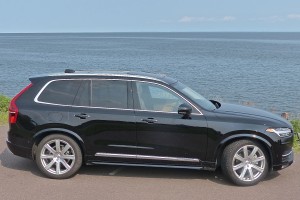
The 2016 XC90 uses its squarish exterior to house a full array of comfort, performance and luxury features.
At 194.8 inches in length, the XC90 is 10 inches shorter than a Tahoe, and 30 inches shorter than a Suburban, but it makes excellent use of its interior space and can tow up to 5,000 pounds with engine choices that include 400 horsepower and 372 foot-pounds of torque.
As unique as the exterior looks, that might be the least impressive of the new XC90’s assets. It comes in three designations — the Momentum, the Inscription, and the R-Design. Each can be had with the choice of engines: the T6, which is a new and sophisticated 2.0-liter 4-cylinder with both supercharging for low-end thrust and turbocharging for high-end power, or the T8 “twin engine” alternative, which has the same T6 engine linked to a C-ISG battery pack/electric motor unit to generate electricity for the latest in hybrid technology.
The T6 produces 316 horsepower and 295 foot-pounds of torque and will zip from 0-60 in about 6 seconds with an EPA fuel economy estimate of 22 miles per gallon. The T8 produces 400 horsepower and 472 foot-pounds, improving acceleration time to 5.6 seconds and attaining a lofty 59 mpg high. With both engines available in all three models, all can be obtained in basic form or with popular options grouped in Vision, Convenience, or Climate packages, and a full slate of specific options also are available.
Prices for well-equipped standard vehicles range from $48,900 for the Momentum T6 or $68,100 with the T8; the high-performance R-Design ranges from a $52,900 base T6 to $70,000 for the T8; and the Inscription opens at $54,500 as a T6 or $71,600 for the T8.
Read more
Advanced Sonata Goes High-tech with Hybrids
Filed under: Equinox, Autos
By John Gilbert
The 2011 Hyundai Sonata was a breakthrough vehicle for the South Korean manufacturer, proving it could out-flank even the Japanese for such technical assets as dramatic contoured styling, a world-class engine with variable valve-timing and other-worldly direct injection, and a new home-built transmission.
Cutting-edge technology, to be sure, but cutting-edge mainstream stuff. Hyundai improved on that model with the 2015 Sonata, but even those advancements couldn’t prepare us for the high-tech leap to the 2016 Sonata Hybrid and Plug-in Hybrid models.
Discussing technical assets can make consumers, and some journalists, take on a glazed-over gaze, but all the technology would be meaningless if the Sonata — or any hybrid — didn’t approach normal-driving capabilities. In that regard, the 2016 Sonata Hybrid sets new standards.
You might even think you’ve gotten in the wrong car when you select “Sport” from the three drive modes, then manually command the Shiftronic transmission to rally the combined forces of the gas-engine and electric-motor and transmission for surprising potency.
“Our development goal was to combine the features of economy and fun-to-drive,” said Yong-Seok Kim, project manager for the Sonata Hybrid. “you can set the manual shift mode for Eco, Norm, or Sport. Our research shows that 45 percent drive in Economy, 35 percent in Normal, and 20 percent drive aggressively.
“With our selective control, you can set it for whichever style you want, then adapt, or let the car adapt to you. We’ve reduced the gap between driving and aggressive driving. Whichever way you drive, as you come up to a stop light and release the gas pedal to coast, you can reduce your fuel consumption by 3 percent.”
Without question, first drives of the Sonata Hybrid on the Los Angeles freeways and through the hills around Los Angeles, proved that the car’s performance is easily as good as the hottest-performing Sonatas.
The hybrid models are virtually a separate class from the normal Sonatas. You can choose a base Sonata Hybrid for $26,000, and add features and capabilities to rise to the Limited, or go upward again to reach the Limited Ultimate.
There are more differences between the Hybrid and the Plug-In Hybrid than merely using Clean and informative dash layout shows current fuel economy over 54 mpg in the Sonata Hybrid.plug-in power to fully recharge, and the Plug-in Hybrid starts at $30,100 as a Limited model, moving up to Limited Ultimate for an extra $4,500. Those prices are only moderately more expensive than the non-hybrid Sonata, and they can fetch you a $4,919 tax credit as well.
While the normal Sonata does well with engines ranging from the 2.4 to the 1.6, including a 2.0-liter turbo, the hybrids make use of the same engine, a newly refined 2.0-liter without the turbocharger.
All hybrids depart from the normal Sonata’s styling, with a more aggressive front grille opening, and revisions to the headlight and taillight housings to aid fuel-economy. In the process, the Sonata Hybrid winds up with a segment-best 0.24 coefficient of drag, lowered from the normal Sonata’s 0.27. Fuel economy can venture beyond the EPA estimated 40-44 miles per gallon highway, by altering heavy-footed driving habits.
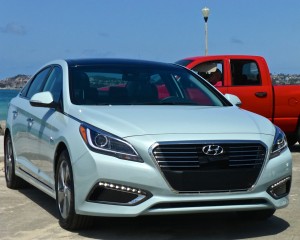
Sonata Hybrids come in Base or Limited, and the plug-in version offers increased power and capability.
By cheating to overuse electric-only power when fully charged, we started out registering 99.9 miles per gallon — because the gadget wouldn’t measure three digits. Continuing beyond about 24 pure-electric miles, we still averaged 68.8 mpg for the first leg. My partner, whose right foot always seems closer to the floor, reached as high as 59.6 mpg at a sustained 70 miles per hour.
The current Sonata had a hybrid model, but it wasn’t about to challenge the industry leading hybrid sedans from Toyota or Honda. The new car challenges everything on the market. To start with, Hyundai will aim sales at the West Coast, where there are an abundance of quick-charge stations. But buyers farther inland can order the Hybrid or Plug-in Hybrid and find their own way to capitalize on all the features.
The secret of advancing hybrid technology is that car companies aren’t in the battery-making business, so coordinating with battery companies is vital. Hyundai has a fellow-South Korean ally in LG Industries, and a newly created LG Lithium-polymer battery pack feeds Sonata’s permanent magnetic synchronous motor and clutch arrangement, with is located where the 6-speed automatic transmission’s torque converter normally would be. That unique coupling is the ideal way to blend the electric power with that new 2.0-liter gas 4-cylinder engine.
Taking away the turbo reduces the power of the normally-aspirated 2.0, but it gets more than sufficient power with the added power surge from the electric motor. In fact, the power assist comes in two doses, depending on whether you have the normal or the plug-in hybrid.
The 2.0 gas engine by itself has 154 horsepower peaking at 6,000 RPMs, and 140 foot-pounds of torque at a high 5,000-rev peak. The LG battery unit with its vertical plates in a more compact alignment, adds 51 horsepower from a 1,770-2,000 RPM peak in the Hybrid, or 67 added horsepower from 2,330-3,330 RPMs in the Plug-in Hybrid. Both benefit from the boost of 151 foot-pounds of torque from the electric motors, which operate at that peak all the way from 0-1,770 RPMs.
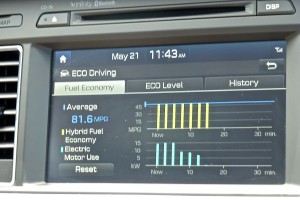
Alterations to the 2016 Sonata Hybrid are more attractive with the chance to beat 50 miles per gallon.
Doing the math, the Sonata Hybrid has 193 horsepower, and the Plug-in Hybrid has 202 horsepower. A larger battery pack is needed for the added power, and that boosts the weight of the Hybrids (3,497-3,560 pounds) to the Plug-in’s 3,787-3,810 pounds. But starting out in the morning with a full charge means you can drive the full 24 miles on pure electric, which exceeds the prime contenders, the Fusion Energi and the Accord plug-in hybrid.
Getting to that full charge offers an interesting choice, too. If you plug into a normal household outlet of 110/120 volts (Level 1), you’ll need 9 hours to reach full charge. If you have the 220/240 Level 2 outlet, you can reach full charge in only three hours. Using the normal internal charging system that takes power from the gas engine and regenerative braking means an owner could drive the Sonata Hybrid “normally” and not realize it’s a hybrid from performance, unless the over-40 mpg made the driver curious.
Hyundai’s John Shun, who oversees Sonata Hybrid production, said, “You can maximize miles per gallon over fun-to-drive, or vice versa. For example, in Sport, you get immediate throttle response, in Normal you get normal response, and in Eco, there’s more hesitation when you use regular throttle pressure.”
For the curious, you can coax the Sonata Hybrid up to 75 miles per hour on pure electric, although that might drain the battery’s power quicker. Shun said all the latest safety tricks are on the Sonata Hybrids, including blind spot detection, lane departure warning, a rear parking sensor, and forward collision warning, and so anxious are Hyundai engineers to make the Sonata safe, a “virtual” engine sound system will be coming next, to alert pedestrians who might not hear the electric-powered hybrid approaching while doing their text-walking maneuvers.
Other neat features include a 5-inch touchscreen and an 8-speaker audio, an upgraded 8-inch screen and a 9-speaker, 400-watt audio, or an electroluminescent instrument light show that can replace the tachometer with a power-consumption gauge, and includes a 4.2-inch trip computer. Buyers can choose an energy gauge that indicates battery charge, range, and the energy flow the way you are currently driving, and with the Blue-link smart-phone app, you can seek out high-speed charging stations.
In the rear, the Sonata boasts of being the only midsize hybrid with a flat cargo floor. Combined with the split fold-down rear seat, cargo volume reaches 13.3 cubic feet, decreased to 9.9 with the larger battery in the Plug-in. Those things might be more important in marketing than such items as the motor-driven, RPM-sensing, rack-and-pinion power steering.
But with the 2016 Sonata Hybrids, buyers have to accept both — creature features and high-technology advances.
Alfa Romeo Doesn’t Spare Theatrics for New Giulia
Filed under: Equinox, Features, Autos
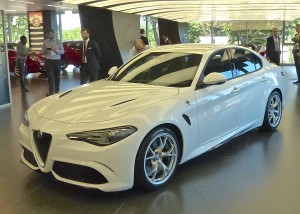
Alfa Romeo unveiled the new Giulia midsize sedan as the focal point of its return to competitiveness.
By John Gilbert
MILAN, Italy — When Italians decide to do something, they tend to do it wearing their emotions on their sleeves. Or at least their fenders. That unrestrained optimism accompanied the world introduction of the new Alfa Romeo Giulia, a sport-luxury sedan that is a perfect example of living up to the hyperbole accompanying that legendary Italian passion.
There is no argument about how important the new Giulia sedan is to “resurrect” Alfa Romeo, just as there is no way to overstate the importance a healthy Alfa Romeo can have for Fiat, and therefore Fiat-Chrysler Automotives, on the world automotive stage. As a midsize sedan, the Giulia is not shooting at Accord, Camry, Fusion, Malibu type sedans. It is aimed directly at the top German performance sedans, such as the BMW M3, the Mercedes AMGs and the Audi S4.
In order to run with, and ahead, of such luminary competitors, governing FCA built an entirely new platform and an entirely new 3-liter V6 with Ferrari engineering. While similar to a Ferrari designed engine used by Maserati in the Ghibli sedan, some media types assume that is the Giulia engine — a point Alfa officials refuted almost to the point of confrontation. We will believe that the Giulia V6 is all new.
Alfa built the mid-size sedan in almost total secrecy, engaging what it calls a “skunk-works” of devoted and single-minded engineers to design and build the car. That term dates back to World War II, when Alfa engineers wanted to hide their latest prize from the Fascist Italian government, and joined the secret Lockheed project to develop the F80 Shooting Star jet fighter that helped hasten the end of the war.
For the Giulia introduction, Alfa summoned several hundred automotive journalists from all over the world to come to Milano where the car shared the spotlight with the opening of the Alfa Romeo museum, with its display of hundreds of vehicles that trace the 105-year history of Alfa car-building.
In the museum’s auditorium, Alfa Romeo president Harald Hester started the show, followed by chief engineer Philippe Krief, and design chief Lorenzo Ramaciotti. When Ramaciotti talked about the passion that is an Italian hallmark, he mentioned how it is similar to Italian classical music, such as that performed by brilliant tenor Andrea Bocelli. At that moment, Bocelli was escorted onstage. He read a love poem he had written, and then he sang “Nessun Dorma,” and when he hit the operatic crescendo, a stunning red Giulia sedan was driven out on the stage behind him.
Theatric overkill? More like colorful Italian tradition.
Sergio Marchione, chairman of Fiat Chrysler Auto, was next at the podium. “Over two years, we developed a quintessential example of all that made Alfa Romeo a car coveted by passionate drivers the world over,” said Marchione. With 510 horsepower and 0-100 [kilometers] acceleration in 3.9 seconds, we have created a car that has no need to be compared to others.
“This is one of the most impressive cars I’ve ever been associated with,” Marchione added, noting that the “skunks” at the skunk-works were able to think outside the box, starting with a clean sheet of paper, and “unimprisoned by barriers we sometimes build for ourselves.”
It’s easy to see why Marchione is the head man at Fiat Chrysler Auto, which includes all things Fiat, Alfa, Ferrari, Maserati, Lancia, Chrysler, Dodge, Ram and Jeep. Fiat returned to the U.S. only after the parent company took over the faltering Chrysler LLC, and is just now reintroducing Alfa Romeo to the U.S. Those old enough to remember might best recall Alfa for the sleek little roadster Dustin Hoffman drove to try to interrupt Katherine Ross’s wedding in the timeless movie, “The Graduate.”
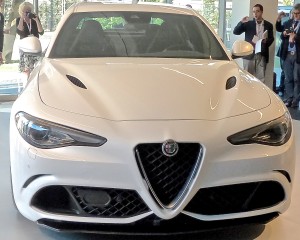
Familiar triangular Alfa center point on the grille links thoroughly modern Giulia with historic past.
While Alfa has slipped in popularity, almost to extinction, its heritage has remained strong, and new models like the 4C sports car and the Giulia are just the beginning of the planned resurrection.
“Alfa Romeo has a legendary place in automotives,” Marchione added. “It has so many admirers throughout the world, but it has not been reflected in commercial success. Other than Ferrari, and maybe Jeep, I don’t know of any other car capable of expanding so much of its core tradition.”
We couldn’t drive the cars, yet, so we had to be satisfied with their stunning appearance, and the deft descriptions by Alfa executives. Hester opened the program describing the uniqueness of the brand and said, “Making and creating are not the same thing. We wanted to create something different, to put the driver back at center stage. An Alfa Romeo is never just a car, just a machine. It is beyond the scope of being just a machine.”
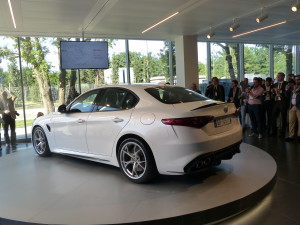
All the sleek lines reach a harmonious conclusion at the rear of the Giulia, which takes aim at the BMW M3.
Chief engineer Krief explained the rear-wheel or all-wheel platform, housing the all-aluminum 6-cylinder bi-turbo engine, featuring Ferrari technology and engineering skill. “Turbo lag is nonexistent, and it has excellent torque at all RPMs,” Krief said. “It also has cylinder deactivation, and Alfa invented that technology in the early-‘80s. We then worked to get the engine to sing, as it should. The Giulia has 50-50 weight distribution, and our level of driving enjoyment depends on the suspension, which has ‘Alfa Link’ at the rear for maximum movement control, and double wishbone in front with a new steering system that is the most direct on the market. It has carbon ceramic brakes, and the best torsional rigidity in its class.
“Electronics are used to increase performance, not cover up shortcomings, and it has real torque-vectoring, with a double clutch system to separate the torque going to each wheel. Rear-wheel drive can be a problem on slippery roads, which is why we also offer all-wheel drive. The response is quick and it has the lowest coefficient of drag in the segment, with a front aero splitter, so it is safe to drive, even at very high speed.”
The interior is filled with classic features, real wood and real leather surrounding everything, including a console that has two round knobs. The left knob is smaller, thankfully, and it directs the driver to N, A, D, and Race. The N is for normal operation, the A is for Advanced, the D for Dynamic — which is more advanced — and the Race is for a full-out race-smooth performance setting. That control governs the direct-sequential gearbox as well as the suspension firmness and the amount of effort necessary to send the Giulia down the road.
Design chief Ramaciotti said the organically shaped car “challenges time, passion and space with its tension — part of the culture at Alfa Romeo. The short overhangs, long wheelbase, compact body, and simplicity” is the feature of the exterior, with its Alfa-emblem nose and elegant silhouette. Inside, he said, “all you see is leather, wood and carbon fiber. The whole package is a coveted object of desire, not an ornament.”
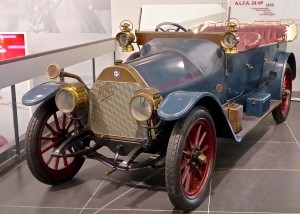
Alfa takes great pride in building passionate cars, starting with the first one, this 1910 museum piece.
Marchione said FCA plans a rapid expansion for Alfa, which reportedly includes a crossover SUV/van, a larger sedan, and enough other models to sell 400,000 vehicles worldwide by 2018. The museum, filled with classic vehicles dating from the 1910 model and on up to the current era, including 1937 and ’38 Giulia and Giulietta models, and a Gran Primo race car that had two Ferrari V12 engines — one in front and one behind the cockpit.
“It will be easy to rediscover Alfa Romeo’s identity,” said Marchione, “because Alfa has lived through, and often written, so much history.”
If You Want a Hybrid, Would a BMW i8 Do?
Filed under: Weekly test drives, Autos
By John Gilbert
Since my first turn in a 1968 2800 CS Coupe, I’ve driven virtually everything BMW has produced, which includes the 1600 and 2002, continues on through the 3-Series, 5-Series, 7-Series, the newest 1, 2 and 6 models, assorted X-model SUVs, and a couple more I’ve overlooked.
A couple of certainties follow: 1. All of them were and are impressive from an engineering and utilitarian standpoint, and 2. None of them could possibly prepare you for a drive in the i8.
The 2015 BMW i8 is the ultimate dream car. A reason-bending concept car brought to life, fulfilling fantasies and adding futuristic ideals that reach beyond those fantasies. We all have been reading about the latest global-warming, climate-changing, high-risk trends of today’s world, and the most logical conclusion is that our driving machines are going to become electrified in some manner. So why not make a lifestyle statement and make your next car a hybrid?
Also, if you live in a Northern climate, rich with snow in the winter, all-wheel drive is a nice feature. Let’s further imagine that you could buy any car on the planet — although that might be a bit harder to grasp. The i8 price tag is $136,650. If you hear the price while gazing at the car, it doesn’t seem as shocking. Especially if you have any idea of the price sticker for a Ferrari, Porsche, Maserati, Jaguar, McLaren, or Aston Martin.
As far as other subjective characteristics you and your co-driving wife might embrace, you’d obviously prefer something visually striking, maybe a great looking sporty car with the added emotional investment of performance that’s up there with the elite top exotics. The BMW i8 can meet and exceed all those fanciful ideas.
It is built of carbon-fiber, that magical material that is, they say, three times lighter and several times stronger than steel. The car weighs in at 3,378 pounds, all of which are distributed front to rear at a nearly ideal 49/51 ratio.
I hadn’t bothered to investigate the i8’s details fully since it started making the auto-show round, because I suspected it might just be a design exercise. When one appeared in my driveway in Duluth, Minnesota, however, it was time to either learn about it or find a respirator. I knew BMW had come out with an electric i3 subcompact sedan, but I still couldn’t believe the i8 had been brought to life.
For visual impact, there may be nothing else that approaches the stunning looks of the i8. If there is, it would have to be a $300,000-range super-car named Ferrari, Lamborghini, or McLaren.
The i8 is a glistening metallic silver, with a black roof panel, and black lower sides tastefully set apart by an electric-blue borderline that varies in width. That lower black wraps around the lower front end, and rises up to fully set off the rear end’s dramatic curves and layers. The i8 is so low that you feel that with a couple of hard strides you could quite easily hurdle it.
At the time, and maybe still, there had never been another i8 in Duluth, or anywhere else in Northern Minnesota — even passing through. It’s important to look cool when you’re approaching a car like this, but any semblance of patience disappeared when I popped the driver’s door, which swings upward, hinged in front, and displays the low bucket seats. You might at first overlook the fact that there are two jump seats behind those buckets, and overlooking them is probably a good idea, because a human would have to be tiny to even attempt to squeeze back there.
Never mind all that. You’re in the driver’s seat, and you have fired up the ignition and moved the shift lever into its drive slot. That takes a bit of ingenuity, just getting it out of park and past reverse. The indicator says I’ve successfully engaged first, so we’re off. The car shoots forward, instantly gaining your full respect with its super-car-like acceleration. Sounds good, too, although you ain’t heard nothing, yet.
Handling is incredible. The car is so low, with such a low center of gravity, that you feel you might become part of any road irregularities. You are encased in the bucket seat with excellent support, and snaking around turns on the curviest smooth roadway you can find is a joy to experience in the i8. Imagining it on a road-racing track is automatic, but so is straight-line acceleration.
Less attractive is planning to extricate yourself from the cockpit. Getting in is no problem, because you learn ways to go in backwards or sideways and pull in your legs later. Getting out, though, requires some gymnastic agility. I developed a partial-Western-roll, much like high-jumping form. Start to roll on your side, fling a leg out, and do a little hop-step, hoping that you land on your feet.
Driving through town is an interesting experience, because unless you’re a complete show-off, you try to avoid glancing in either direction, where everybody on either sidewalk has stopped, frozen in their tracks, to stare wide-eyed and slack-jawed at this apparition.
The only folks who might take action are those in other vehicles — even sensational other vehicles — making u-turns and following you to wherever you’re going. Pull off onto an exit ramp and the mirrors indicate you’re the lead car of a parade. You stop, and you are immediately surrounded by a herd of folks who just want to know about the car.
The i8 will shoot 0-60 in 4 seconds; maybe a couple ticks less. I have no idea what the top speed might be, although someday I’d like to find out, if a road-racing track or an autobahn becomes accessible.
It has 362 horsepower and 412 foot-pounds of torque, and we haven’t even gotten to the surprises yet.
First surprise: The engine is a 3-cylinder, measuring 1.5 liters. Huh? BMW is one of the world’s leading proponents of making engines smaller and more potent, and it makes modular sense to build engines that measure a half-liter per cylinder. A 6-cylinder measures 3.0 liters, and the 4-cylinder measures 2.0. Taking off one more cylinder leaves you with 1.5 liters.
Surprise No. 2: The tiny engine is turbocharged, making those 4-valves-per-cylinder pistons churn up and down in well-choreographed harmony.
Surprise No. 3: The i8 is a hybrid. Two electric AC-induction motors operate off a 7.1 kilowatt-hour, lithium-ion battery pack.
Surprise No. 4: The i8 has all-wheel drive. That helps it handle so dramatically well, but required precise calibration back in the factory laboratory.
Surprise No. 5: The coordination approaches miraculous. The gas engine develops 228 horsepower and the electric motors add 129 horsepower for a combined 362. The gas engine alone develops 236 foot-pounds of torque, while the electric motors add 184 more, reaching that 420 figure. The turbo gas engine powers the two rear wheels through a 6-speed automatic transmission; the two electric motors push the two front wheels via a 2-speed transmission. Coordinating it all is seamless and smooth to the driver.
As with any hybrid, a careful driver can coax a certain distance on silent electric power alone, but it takes patience. Ideally, you’d want to plug your i8 in for an hour on a 240-volt, 80-amp charger, or a bit longer on normal household 110, to get it fully charged. if you drive away and step lightly on the gas pedal, you can go silently and effortlessly for about 25 miles on pure electric. Stepping on the gas hard, or trying to accelerate quickly, brings the gas engine on to join the electric, which might be more satisfying, but cuts into your green-ness.
Gauges tell you when you’ve about exhausted the electricity, after which you’ll go on gas-engine only.
Then there’s Surprise No. 6: Pull the shift lever over to the left, into “Sport,” and you immediately get a surge both in power and in exhilaration, because the sound — helped by amplification through the speakers — is almost other-worldly with its snarling roar. It is in that Sport mode that the engine uses the gas engine’s power to help regenerate the battery pack. Recharging never sounded so sweet.
You won’t ever reach full charge with just the gas-engine input, so plugging in the i8 makes the best sense. Still, all-electric cars run impressively for a limited distance, then need to stop for several hours of recharging, no matter what time the game starts. You can keep driving on gas in the i8, and driving also juices up the battery pack enough to enjoy more full-electric driving, though for briefer stretches. Just like a “normal” hybrid.
If you owned an i8, you would develop some tricks to keep it charged and increase your effective fuel economy up to lofty heights, like maybe 75 or so miles per gallon.
Just remember that ace in the hole, for justifying such a large chunk of the family budget. Come home and announce that you’ve made the decision to help the world and your winter challenges by getting a car that is both a hybrid and an all-wheel-drive vehicle. Then let her get a glimpse of the i8 parked outside. Chances are she’ll be so blown away she won’t even ask you how much it cost.


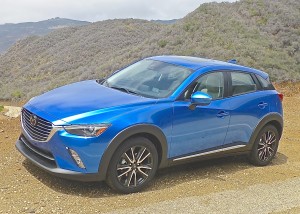
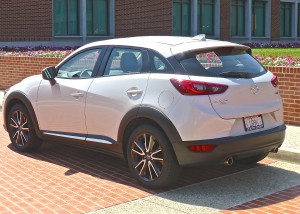
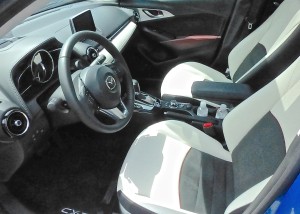
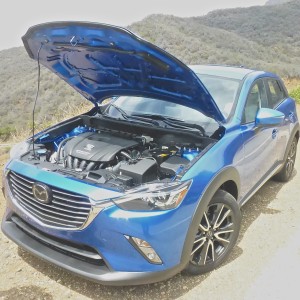
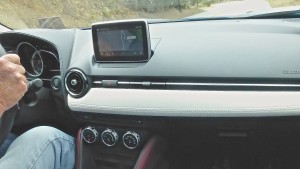
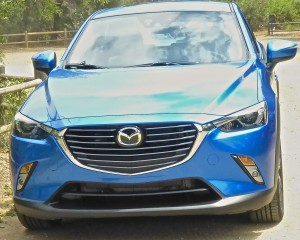
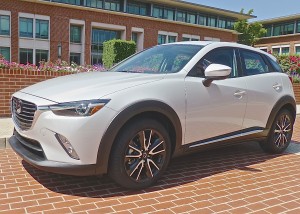
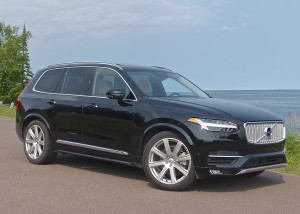
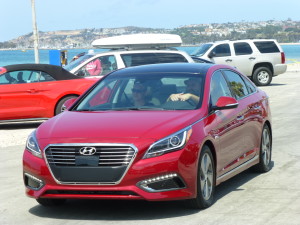
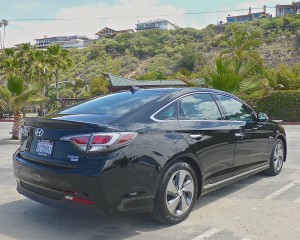
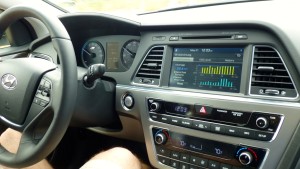
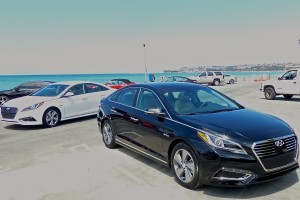


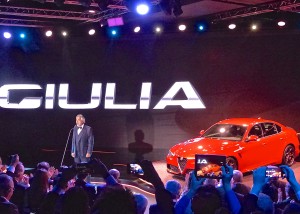
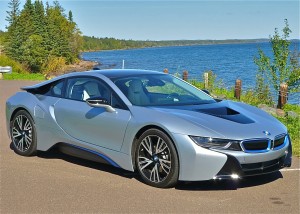

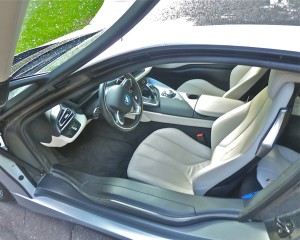
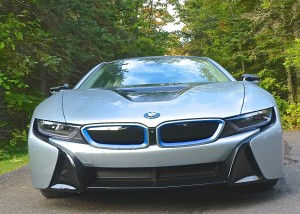

 John Gilbert is a lifetime Minnesotan and career journalist, specializing in cars and sports during and since spending 30 years at the Minneapolis Tribune, now the Star Tribune. More recently, he has continued translating the high-tech world of autos and sharing his passionate insights as a freelance writer/photographer/broadcaster. A member of the prestigious North American Car and Truck of the Year jury since 1993. John can be heard Monday-Friday from 9-11am on 610 KDAL(www.kdal610.com) on the "John Gilbert Show," and writes a column in the Duluth Reader.
John Gilbert is a lifetime Minnesotan and career journalist, specializing in cars and sports during and since spending 30 years at the Minneapolis Tribune, now the Star Tribune. More recently, he has continued translating the high-tech world of autos and sharing his passionate insights as a freelance writer/photographer/broadcaster. A member of the prestigious North American Car and Truck of the Year jury since 1993. John can be heard Monday-Friday from 9-11am on 610 KDAL(www.kdal610.com) on the "John Gilbert Show," and writes a column in the Duluth Reader.